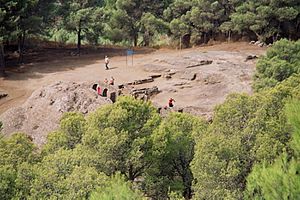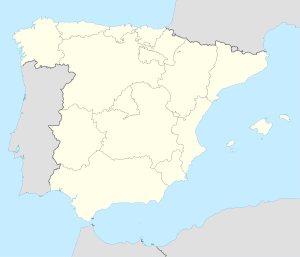Bobastro facts for kids
Quick facts for kids Bobastro |
|
|---|---|

Ruins of the Bobastro Church
|
|
| Coordinates | 36°54′9.01″N 4°46′53.35″W / 36.9025028°N 4.7814861°W |
| Type | Castle |
| Site information | |
| Condition | Ruins |
Bobastro (Arabic Bubashtru) was an old castle in Spain. It was first built by the Romans a very long time ago. Later, it became a very important place for a leader named Umar ibn Hafsun. He used Bobastro as his main base when he rebelled against the powerful rulers of the Caliphate of Córdoba in the 800s. Today, you can still see the ruins of this historic castle in the Province of Málaga, Spain.
Contents
Exploring Bobastro: An Ancient Castle
Bobastro is a fascinating historical site. It shows us how people lived and fought many centuries ago. The castle's ruins are found in a beautiful part of Spain. They tell a story of power, rebellion, and change.
Bobastro's Roman Beginnings
Long before Umar ibn Hafsun, there was already a structure at the Bobastro site. This first building was built by the Romans. They were a powerful ancient empire. The Romans often built forts and castles in important locations. This helped them control their lands.
Umar ibn Hafsun's Rebellion
In the year 880 AD, a man named Umar ibn Hafsun came to Bobastro. He settled in the ruins of the old Roman castle. Bobastro was near a town called Ardales. Umar ibn Hafsun was not happy with the rulers of the Caliphate of Córdoba. These rulers were collecting very high taxes. They also treated some groups of people unfairly.
Umar ibn Hafsun encouraged people to join him. He gathered support from the Muwallads and Mozarabs. These were groups of people who felt unfairly treated. They joined his cause against the Caliphate. Bobastro became the main headquarters for his rebellion. It was a safe place for him and his followers.
A Church Within the Castle Walls
During the rebellion, Umar ibn Hafsun and his followers built a church inside the castle. This church was an important part of their community. It showed their faith and their new way of life. The church stood for many years. It was a symbol of their independence.
The End of Bobastro's Importance
The rebellion lasted for a long time. But eventually, the Caliphate of Córdoba fought back. On January 19, 928, the rebels lost their independence. The castle and the church were no longer under their control.
Even after the rebellion, Bobastro was still used for some time. Records show it was still active in 1147. However, by the 1200s, the castle had fallen into ruins. Today, it stands as a reminder of a dramatic period in Spanish history.
See also
- In Spanish: Bobastro para niños



